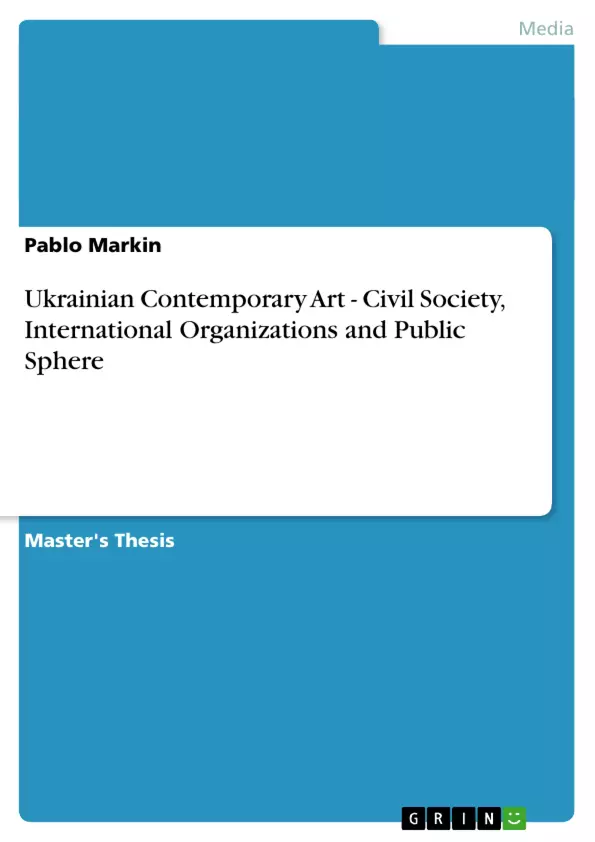The independence of the countries that have succeeded the Soviet Union in 1990s has created basic conditions for the institutionalization of the civil society in these states. Ukraine has joined these newly independent states with little reliance on the institutions of the civil society. The developments within the Ukrainian art reflect the implications that the failure of the civil society institutionalization has for this particular domain of Ukrainian society. Ukrainian contemporary art that is presented at the major international art museums and art festivals of the contemporary art is a post-Soviet phenomenon that occupies the junction between Ukrainian art, international institutions and civil society. As a field of artistic activity Ukrainian contemporary art strives to differentiate itself from Ukrainian art that originated in the environment largely formed in the pre-independence, Soviet period. The struggles for authority within the field of Ukrainian contemporary art have involved Ukrainian institutions that are outside of it. Both institutional and personal agency within the field of Ukrainian contemporary art is affected by the lack of institutionalized civil society in Ukraine. In the theoretical terms of Pierre Bourdieu it is the case of the lack of autonomy that the field of Ukrainian contemporary art has. The sought-for autonomy would allow the field of Ukrainian contemporary art to exercise control over the resources of artistic authority. How this finds its articulation in the personal narratives of the major Ukrainian contemporary art figures and in the conflicts that happen in the field of Ukrainian contemporary art is the topic of this research. The methodology of multi-sited anthropology adopted in this research makes it possible to trace the contours of the authority relationships among contemporary artists, art institutions and curators at the time of inquiry. The research draws on twenty in-depth interviews arranged in 2001 with the leading figures of the Ukrainian contemporary art, with the prominent art curators that cooperate with the Ukrainian contemporary artists, and with the representatives of the major contemporary art galleries and foundations of Ukraine.
Inhaltsverzeichnis (Table of Contents)
- Abstract
- Introduction
- Theoretical Background
- Ukrainian Contemporary Art
- Struggles for Professional Authority
- Role of Social Capital
- Art Establishment vs. Contemporary Art
- Claims for Professional Identity
- International Recognition Contingencies
- Conclusions
Zielsetzung und Themenschwerpunkte (Objectives and Key Themes)
This thesis examines the development of Ukrainian contemporary art in the post-Soviet era, focusing on the interplay between artistic practice, institutional structures, and the nascent civil society. It investigates how Ukrainian contemporary artists have navigated the challenges of establishing professional authority and gaining international recognition within a context characterized by a lack of established institutional support.
- The impact of the absence of a robust civil society on the development of Ukrainian contemporary art.
- The struggles for professional authority within the field of Ukrainian contemporary art.
- The role of international institutions and organizations in shaping the trajectory of Ukrainian contemporary art.
- The relationship between Ukrainian contemporary art and its pre-independence, Soviet-era counterpart.
- The agency of artists, curators, and institutions in navigating the complexities of the art world.
Zusammenfassung der Kapitel (Chapter Summaries)
The Abstract provides a concise overview of the thesis's central arguments. The Introduction sets the stage by examining the emergence of newly independent states from the former Soviet Union and the implications for civil society development, specifically within the context of Ukrainian art. The Theoretical Background section lays out the theoretical framework. The chapter on Ukrainian Contemporary Art discusses the emergence of a new generation of artists and the formative influences on their work. The chapter on Struggles for Professional Authority delves into the challenges faced by Ukrainian artists in establishing their professional credibility. The chapter on the Role of Social Capital explores the social networks and connections that influence artistic careers. The chapter on Art Establishment vs. Contemporary Art contrasts the established art world with the newer contemporary art scene. The chapter on Claims for Professional Identity focuses on the artists' efforts to define their professional identities. The chapter on International Recognition Contingencies investigates factors contributing to international recognition of Ukrainian contemporary artists.
Schlüsselwörter (Keywords)
Ukrainian contemporary art, post-Soviet art, civil society, institutionalization, professional authority, international recognition, social capital, art establishment, artistic identity, multi-sited anthropology, Bourdieu.
- Quote paper
- Dr Pablo Markin (Author), 2003, Ukrainian Contemporary Art - Civil Society, International Organizations and Public Sphere, Munich, GRIN Verlag, https://www.grin.com/document/121173



